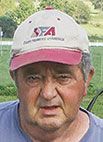
Roots run deep at Styles Ranch in Coal Hill, Ark. Jamey Styles’ father was an Ag teacher at Hartman and Coal Hill, who had started out teaching Vocational Agriculture to the newly-returned veterans of World War II in the late 1940s. He was an innovative farmer and owned both the first automated square baler and the first round baler in the county. The family raised cattle, horses and hay in the fertile river bottoms of Johnson County.
Jamey and his wife Angela left the farm in 1988 for Angela to start medical school. Jamey worked at the Arkansas State Plant Board as an agricultural specialist. He returned home to continue running the farm when his dad passed away in an accident in 1989. They purchased the farm in the late 1990s from his mother after Angela returned home and started her Dermatology and Dermatopathology practice. Now, they follow the tradition of raising their family on the same land with their five children: Silas, 12, Sylvia, 10, Stella, 8, Stacia, 5, and Stet, 2. Over the years they have added to the original farm by purchasing and renting additional bottomland, some of which was previously farmed by Angela’s grandfathers.
Angela recounted the story of how they discovered their blue ribbon hay. “Jamey spent hours, year after year, going round and round these fields working in the hay. He observed that some areas of grass did better than others. There were stories from the older farmers that there were strains of bermuda that you just couldn’t kill. Jamey worked with the County Extension Agent, Blair Griffin. They sampled the areas that were more drought and disease resistant and the best quality. They took that and propagated it. They discovered that Jamey’s best grasses were a mutated common Bermuda.”
“We named it Genesis because God gave it to us,” Jamey said. He added that Genesis Bermuda is the only variety developed outside of a University that has won a national award. It is leafy, low in fiber and high in digestible protein, leading to a higher relative feed value.
Jamey and Angela attribute all of their success to God’s blessings. In 2011, Jamey took the top award for the National Hay Contest hosted by the American Forage and Grassland Council (AGFC). This year, Jamey took second. Silas, who is mowing and baling his own hay now, took third with his entry.
Jamey is one of few participants in Arkansas’ “Quality Forage” program outside of Benton County. He explained that the optimum growing area is in northwest Arkansas because they are at the northern edge of where Bermuda will grow. He said that quality of Bermudagrass is normally lower at warmer temperatures.
They market baled hay, as well as selling sprigs every year. Primarily, their hay sales are to buyers in Arkansas, Oklahoma and Texas. “Our niche is really the horse market for the large square bales,” he said. “But we also sell to some dairies and farmers that are backgrounding their calves.”
Jamey has gradually sprigged most of the farm in Genesis. “I use litter and commercial fertilizers. It depends on availability. I target potash because Bermuda uses a lot. I use 0-0-60. It is amazing how much you deplete in one year,” he said. Jamey explained that they test their soils every year or two. “With the same crop you can tell when you are seeing issues so we use the soil tests to back up our gut,” he said. He added that yellowing or spotting was a sign of depleted nutrients.
Jamey also has several irrigation units installed. “We use T&L hydraulically driven center pivots,” he said. “I estimate that each unit can cover 150-160 acres.” Jamey irrigates according to soil moisture. He explained that optimum moisture is when the moisture layers meet so there is no dry layer between them.
The haying equipment is a major part of Jamey’s business. “We have several different brands. I have a lot of Kuhn and John Deere,” he said. He is continuing his father’s innovation on the hayfield by having a Kuhn 30-foot front mount butterfly mower that allows him to mow 20 acres per hour.
“We have four to five herds of cattle. “I try to keep them about ¼ Brahman for heat tolerance,” he explained. “I try to mix and match my bulls to keep calves more uniform, color-wise,” he said. “We have a few Tigerstripes. I think they make the best mommas.”
Through the years Jamey has also maintained a cutting and working horse herd that still has some of the same bloodlines that his father had. Although they aren’t breeding as intensely as they have in past years he said that they still produce some foals every year.
Styles Ranch employs three full-time helpers. Heath Williams who Jamey said is the “cowboy” because he manages the livestock and Lindy Harvey and Robert Abbot, manage the haying and farming sides.







